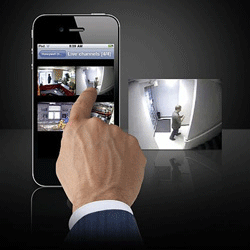One of the biggest advances of business surveillance and business security is the capacity for Mobile devices to deliver remote video to business owners and managers. The delivery of video to mobile devices saves time and resources.
With the advances of handheld devices and mobile smartphones, security command centers are becoming increasingly mobile. Employees or business owners monitoring a business location, no longer have to be onsite to see what is happening on the premises of their work place. With the help of security cameras and smartphones applications, business owners and certified employees can now access businesses surveillance camera footage virtually anywhere they have internet access.
“Imagine this scenario: A large, often unmanned utility substation has suffered repeated acts of vandalism from theives looking to steal copper and other valuable materials. The utility operator installed cameras aroudn the site perimeter in an effort to deter thieves and otherwise monitor any potential criminal activity. The company’s security director is watching a weekend football game in his living room when his smartphone beeps with an email alert warning of an alarm at the substation. He picks up his tablet and opens an app that allows him to pan and zoom the camera to see real-time video from the site. The problem turns out to be no more serious than a deer repeatedly running into the perimeter fence, and he goes back to enjoying his game.” (Arcement, Brandon. Mobile Security: Security’s Range and Capabilities. Volume 15, number 12, page 16. December, 2011.)

This technology will save business owners (or those hired to monitor business security) time and money. This security director would have had to respond to the alarm either by leaving his home and going to the site himself, or he might have had to send someone else to investigate the alarm. Because his mobile device delivered remote video he saved time and resources, thus saving his company money.
Here are several ways that mobile devices deliver remote video:
Sobriety check points and pat downs can use mobile devices to record and transmit real-time video to a command center, thus protecting officers from claims of mistreatment.
Small business owners have the capability and flexibility of monitoring their business location when out in the field, saving them the cost of hiring an onsite security guard.
Security command centers are becoming mobile, allowing more information to be known before guards, officers and other first responders. Officers approaching a potentially dangerous situation or site where an alarm has been triggered now have vital video information. Superiors can oversee their actions from the command center and determine if backup is required.
The biggest advantage when mobile devices deliver remote video, is that there is no need for cabling or even a mass business Wi-Fi network. Video can stream using cellular networks.
Arcement states, “A word of warning before deployment: verify the volume of data to be streamed and check out the cost of data plans from network providers. Adjusting for a slower frame rate, lower resolution or higher compression can reduce bandwidth problems and save money (pg 18).”
Audio is also being integrated with this technology to ensure even more information is streamed to the security command center. “Some organizations also are connecting these mobile devices to emergency notification systems, intercoms and external loudspeakers, allowing officers at an event to communicate directly with the larger community.
Stay tuned for next weeks blog to see more ways that mobile devices deliver remote video and more importantly, how you can get started with mobile security.

